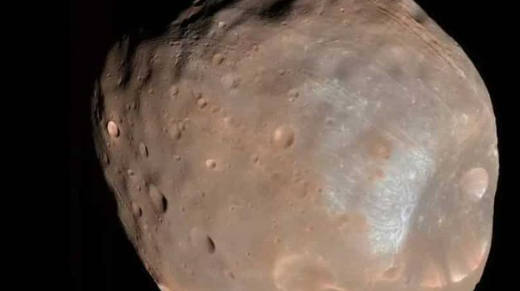Phobos, the moon of Mars, has recently captured global attention, overshadowing common space topics like asteroids and solar storms. This small, oddly shaped celestial body, often likened to a space potato due to its irregular form, is on a tragic trajectory toward Mars, although its eventual demise is not expected to occur for another 50 million years.
Phobos is one of Mars’ larger moons, but it remains relatively tiny with dimensions of 17x14x11 miles. This moon leads a rapid life orbiting Mars up to three times a day. Its size contributes to many of its challenges; its weak gravitational force is not strong enough to mold it into a spherical shape, unlike Earth’s moon, which has sufficient mass and gravitational pull to maintain its round form and stability.
🚀🌌 JUST IN: 🥔 NASA: Martian Moon Phobos Resembles ‘Space Potato’!
Phobos, Mars’s largest moon, looks potato-shaped due to weak gravity. Potential collision with Mars or ring formation in millions of years. HiRISE camera on Mars Reconnaissance Orbiter.
[Source: NASA] pic.twitter.com/4yCqhlchDG
— RSxAI News (@RSxAI_News) June 23, 2024
The moon’s distinctive, lumpy appearance is primarily due to its insufficient gravity to pull itself into a sphere. NASA notes that this lack of gravitational strength gives Phobos its peculiar, potato-like shape. The surface of Phobos is rough, colored in shades of brownish-red, and heavily scarred with craters from constant bombardment by other space objects, such as asteroids. Among these craters, Stickney crater stands out as a particularly massive feature, dominating the moon’s landscape.
The movement of Phobos towards Mars is a slow but steady descent, drifting closer by about six feet every century. Given this rate, it will take an estimated 50 million years before it reaches Mars. At that distant point in time, Phobos will face one of two fates. It could crash directly into Mars, or it could be torn apart by gravitational forces, potentially forming a ring around the planet, much like those encircling Saturn.
NASA’s HiRISE camera captures image of phobos, Mars’ ‘space potato’ Moon https://t.co/U3lIwMZCwS
— WION (@WIONews) June 22, 2024
This recent surge in interest about Phobos highlights humanity’s fascination with the more dramatic and unusual aspects of space. While daily news often focuses on more immediate space phenomena like solar flares and asteroid flybys, the story of Phobos reminds us of the broader, dynamic interactions within our solar system that unfold on much longer timescales.
This narrative of a doomed moon destined to either crash or transform into a planetary ring captures the imagination and offers a glimpse into the natural forces shaping our cosmic neighborhood.
Key Points:
i. Phobos Captures Attention: Phobos, a moon of Mars, has recently overshadowed typical space topics like asteroids and solar storms, drawing global interest due to its unique and tragic trajectory towards Mars.
ii. Small and Fast-Orbiting: Despite being one of the larger moons of Mars, Phobos is relatively small, measuring 17x14x11 miles and orbits Mars up to three times a day.
iii. Unique Shape and Appearance: Often compared to a potato due to its irregular shape, Phobos lacks the gravitational strength to form into a sphere, resulting in a lumpy and cratered appearance, highlighted by the large Stickney crater.
iv. Slow Descent Toward Mars: Phobos is inching towards Mars at a rate of six feet every hundred years, with predictions indicating it will either crash into Mars or disintegrate into a ring around the planet in about 50 million years.
v. Fascination with Space Oddities: The story of Phobos underscores humanity’s fascination with dramatic and unusual celestial events, reminding us of the dynamic and long-term processes occurring within our solar system.
Sylvia Benman – Reprinted with permission of Whatfinger News



